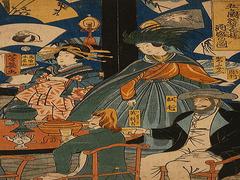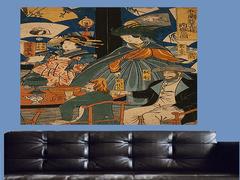Japanese woodblock printmaking, renowned as ukiyo-e, is a captivating blend of artistic skill, intricate craftsmanship, and cultural significance. This intricate process involves collaboration between artists, carvers, and printers to produce vibrant and detailed prints that have left an indelible mark on the world of art. This article delves into the techniques, tools, and traditions that underpin the captivating world of Japanese woodblock printmaking.
The Collaborative Process
Japanese woodblock printmaking is a collaborative endeavor that combines the skills of different artisans. It typically involves three main roles: the artist, the woodblock carver, and the printer. The artist designs the image, often on paper, and then passes it to the woodblock carver, who meticulously carves the design onto individual wooden blocks. Finally, the printer inks the blocks and presses them onto paper to create the final print.
Carving the Blocks: Precision and Skill
The heart of woodblock printmaking lies in the intricate carving of the wooden blocks. Carvers use specialized tools to meticulously cut away the areas that will not hold ink, leaving behind the raised surfaces that will transfer the image onto paper. This requires an exceptional level of skill, as the carver must ensure that the lines and details align perfectly for a flawless print.
Printing: Precision and Patience
Printing is a delicate process that requires precision and patience. The printer carefully inks each wooden block and places paper over it. Using a handheld tool called a baren, they apply pressure evenly to transfer the ink from the block to the paper. Multiple blocks, each inked with a different color, are used to create a multicolored image. This step demands meticulous alignment and a steady hand to achieve the desired result.
Washi: The Choice of Paper
The choice of paper, known as washi, is a crucial aspect of woodblock printmaking. Washi is made from the fibers of plants like mulberry and is known for its durability and absorbency. The texture and thickness of washi affect the final appearance of the print, contributing to its overall aesthetic and tactile qualities.
Color Gradation and Overprinting
One of the remarkable aspects of ukiyo-e prints is the meticulous color gradation achieved through the layering of different colors. By using multiple blocks and precise registration, artists and printers created prints with smooth transitions between colors. This technique, known as bokashi, added depth and dimension to the images. Overprinting, where multiple colors are printed on top of each other, further enhanced the complexity of the final image.
Revival and Contemporary Interpretations
While traditional woodblock printmaking techniques have been preserved, contemporary artists also explore new possibilities within this ancient art form. Some modern printmakers experiment with innovative materials and methods while staying true to the essence of woodblock printmaking. This fusion of tradition and innovation keeps the craft relevant and evolving.
Conclusion
Japanese woodblock printmaking is a testament to the synergy of artistic vision, technical skill, and collaborative effort. From the delicate carving of wooden blocks to the patient application of ink and paper, each step of the process contributes to the creation of a masterpiece. This art form's enduring allure lies not only in the beauty of its final prints but also in the stories of dedication, precision, and cultural legacy that unfold with each stroke and impression.
- Beyond Ukiyo-e: The Diverse Landscape of Japanese Woodblock Art
- Evolution of Japanese Woodblock Printing: Tracing the Roots of an Artistic Tradition
- From Edo to the World: How Japanese Woodblock Prints Shaped Western Art and Culture
- Japanese Woodblock History
- Masters of the Blade and Block: The Collaborative Artistry of Samurai and Woodblock Printmakers
- Resilience and Reinvention: Japanese Woodblock Printing in the Face of Modernization
- Techniques and Traditions: Unraveling the Intricacies of Japanese Woodblock Printmaking
- The Influence of Nature in Japanese Woodblock Prints: Depicting Seasons and Symbolism
- The Societal Mirror: Reflecting Daily Life in Edo Period Woodblock Prints
- The Woodblock Artisans of Edo: Masters of Craftsmanship and Creativity
- Ukiyo-e Renaissance: Exploring the Golden Age of Japanese Woodblock Prints




